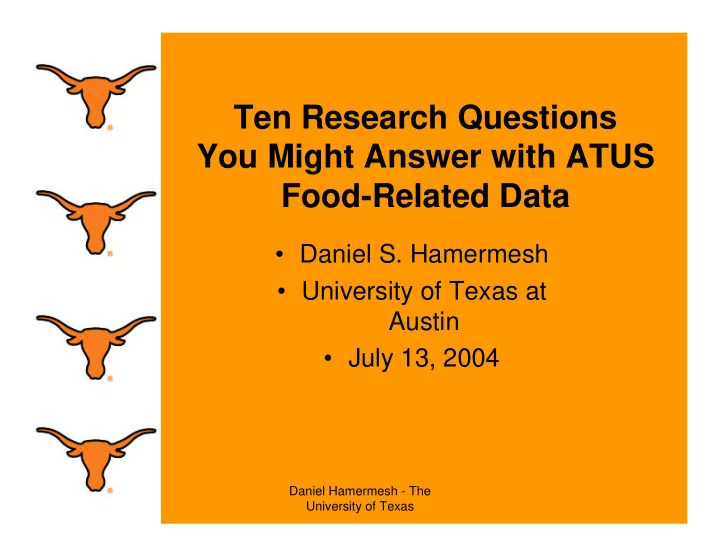

Ten Research Questions You Might Answer with ATUS Food-Related Data • Daniel S. Hamermesh • University of Texas at Austin • July 13, 2004 Daniel Hamermesh - The University of Texas
The Revolutionary ATUS • Immensity of sample size – Four months of ATUS 2003 exceed any previous US sample – 2003-2005 ATUS exceeds any previous sample worldwide • Sample size allows focus on narrow subgroups’ time use • Continuing sample allows measuring changes over business cycles Daniel Hamermesh - The University of Texas
• Allows link to respondents in CPS. This provides information on non-diary spouses. • Allows link to CPS Supplements—e.g., Food Security—for 1/3 of each year’s ATUS respondents. • Allows link to March Income/Demographic information—for 1/3 of the ATUS. • ATUS vaults U.S. from derriere garde to forefront of time-use data worldwide • Caveat: One can hope that research with this rich resource goes beyond pedestrian summing-up of time use by category by demographic group. Daniel Hamermesh - The University of Texas
Integrative Questions • Time-diary data are usually summed into categories • A few sample food categories in ATUS – Grocery shopping – Purchasing non-grocery food – Eating and drinking – Food and drink preparation – Kitchen and food clean-up Daniel Hamermesh - The University of Texas
1. How Are Time and Goods Inputs into Eating Related? • ATUS provides data on all food-related activities. • Link these to 2003 CEX data on food spending • Create age-education-marital status cells • Measure how the time-goods ratio varies across cells—the roles of price of time and income • Assess the “food welfare” of the population— looking at food spending in vacuo is insufficient Daniel Hamermesh - The University of Texas
2. How Have Food Time and Food Spending Changed over Time? • Fundamental U.S. fact—rising earnings inequality since the middle 1970s • Use earlier time-use and CEX data with current CEX, ATUS to examine demographic/economic correlates of changing goods and time inputs into eating • Allows measuring the importance of an additional dimension of changing inequality Daniel Hamermesh - The University of Texas
3. How Do the Location and Time Spent in Food Consumption Relate to Obesity? • Use ATUS location information to examine demographic/economic correlates of where and how much time is spent on eating—food at home vs. food away from home • Relate this information by state or even metro area to obesity data • Is time spent on food—eating, shopping, etc.— related to obesity? Is location? Daniel Hamermesh - The University of Texas
4. What are the Implications of the Social Context of Food Consumption? • Use ATUS data on context (persons) to examine social aspects of food consumption • What determines differences in who consume with? • What are roles of income, value of time, education, etc? • What does this imply about the future demand for food? Daniel Hamermesh - The University of Texas
5. How Does Eating Function as Child Care? • Use ATUS time and context data to examine eating and cleaning-up time with older (>=6) children • How do food-related activities function as child care and attitude formation? Eating together as creating human capital • Are there demographic/economic and geographic differences—what would one expect? Daniel Hamermesh - The University of Texas
6. What Determines Food Shopping Time? • Food shopping is food search—can we use predictions of search theory to develop empirical models of time use? • How does time differ by marital status, demographic/economic correlates? • Are there geographic and urban/ suburban/rural effects? • Can also examine food shopping as a social activity using ATUS context data Daniel Hamermesh - The University of Texas
Instantaneous Questions • Time diaries come in episodes; the activity summaries are computed from the original episode data • Very little research of any kind using timing information (but see DSH papers) Daniel Hamermesh - The University of Texas
7. What is the Role of “Grazing?” • How many times per day do people eat? • How does grazing relate to demographic/ economic characteristics? • Theory might rely on set-up costs, demand for variety • Potential importance for nutrition Daniel Hamermesh - The University of Texas
8. At What Times of Day Do We Eat? • Are there demographic differences in the timing of eating? Is there anything beyond work timing? • Again, potential link to nutrition/obesity issue • Importance of spousal behavior/work— implications for family bargaining Daniel Hamermesh - The University of Texas
9. What is the Role of Eating During Work? • Who is able to eat during work—what is the relation to kinds of work, wages/income? • What does eating during work due to time spent in other eating activities in shopping/ cleaning up? • Is eating during work an amenity— something valued by workers, costly to employers? Daniel Hamermesh - The University of Texas
10. What Determines the Timing of Food Shopping? • When do people shop for food—day of week, time of day? • How is the timing of shopping related to work status, demographics, income and time value? • What are the implications of these facts for regulations involving store opening hours? Daniel Hamermesh - The University of Texas
Recommend
More recommend